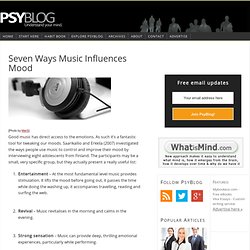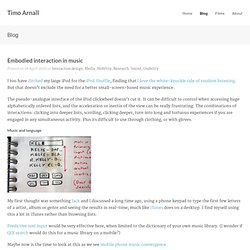

Erik Ubels - The Edge project realiseert innovatie in beheer van vastgoed.
Benchmarks. 10 Magical Effects Music Has On the Mind. Music can improve verbal IQ, aid in heart disease treatment, evoke colours in the mind and even help you see happy faces all around.

Every fan of music knows the tremendous power it can have over both thoughts and emotions. Great music can transform an ordinary day into something magical, even spiritual. It can provide solace, release, strong sensations and more. But music’s influence spreads further still: right up from our genetic code, through our thoughts and bodies and out into how we relate in groups. 1. Practising the piano won’t just improve your musical abilities, it can also improve your visual and verbal skills. A study of 8 to 11-year-olds found that, those who had extra-curricular music classes, developed higher verbal IQ, and visual abilities, in comparison to those with no musical training (Forgeard et al., 2008).
This shows the benefits of learning an instrument are not purely musical, but extend into cognition and visual perception. 2. 3. 4. 5. 6. 7. 8. 9. Extended music education enhancesthe quality of school life. Shivers and Timbres. Unofficial 2012 Impact Factor: 1.263, based on data from Thomson Reuters Web of KnowledgeSM This item requires a subscription to Social Psychological and Personality Science.

To view this item, select one of the options below: Seven Ways Music Influences Mood. Good music has direct access to the emotions.

As such it’s a fantastic tool for tweaking our moods. Saarikallio and Erkkila (2007) investigated the ways people use music to control and improve their mood by interviewing eight adolescents from Finland. The participants may be a small, very specific group, but they actually present a really useful list: Entertainment – At the most fundamental level music provides stimulation. It lifts the mood before going out, it passes the time while doing the washing up, it accompanies travelling, reading and surfing the web. Res, a matter. The Xth Sense is a biophysical musical instrument.

With it you can produce music with the sound of your muscles. It is free and open source, and it was named the “world’s most innovative new musical instrument” by the Georgia Tech Center for Music Technology (US, 2012). Its name is spelled ecsth sense (not tenth sense!). But it’s way easier to call it XS. You can build an Xth Sense and learn how to use it at one of the regular workshops taught wordlwide by the Xth Sense, creator Marco Donnarumma. The Xth Sense forum lives at Createdigitalnoise/xth, and you can connect with us on Facebook too. Designing for Embodied Interaction with Sound.
The development surrounding digital music interface (DMI) technologies have begun to con- sider embodied and enactive design approaches [1, 2].

This has largely been driven through the need to address ongoing problems that are common across many DMI’s [1, 3, 4]. This shift in design perspective is in following traditional Human Computer Interaction (HCI) which is now thought to be moving towards a third paradigm, which is considering phenomenological approaches within its practice [5]. This research intends to build on the work that has already been completed within the field that has centred on embodied and inactive approaches to the design and contraction of DMI’s and New Interfaces for Musical Expression (NIME).
However the focus of this research will be centred around the user of such interfaces. Even with the emerging shift to consider embodied ideas, the focus of design is still heavily centred towards the interface itself. Timo Arnall. Embodied interaction in music – Timo Arnall. I too have ditched my large iPod for the iPod Shuffle, finding that I love the white-knuckle ride of random listening.

But that doesn’t exclude the need for a better small-screen-based music experience. The pseudo-analogue interface of the iPod clickwheel doesn’t cut it. It can be difficult to control when accessing huge alphabetically ordered lists, and the acceleration or inertia of the view can be really frustrating. The combinations of interactions: clicking into deeper lists, scrolling, clicking deeper, turn into long and tortuous experiences if you are engaged in any simultaneous activity. Plus its difficult to use through clothing, or with gloves. Music and language My first thought was something Jack and I discussed a long time ago, using a phone keypad to type the first few letters of a artist, album or genre and seeing the results in real-time, much like iTunes does on a desktop.
Maybe now is the time to look at this as we see mobile phone music convergence. DJammer. Overview The HP DJammer portable appliance could be the next generation of MP3 players.

Building on top of current MP3 players, the HP DJammer has the following two additional functionalities: a personal DJ User Interface (UI), and a live digital session with one (or more) similar HP DJammer appliance enabling listeners to create music and digitally mix in real-time together (hence the term jamming). Various DJ UI are implemented with buttons, wheels and knobs similar to currently available MP3 players.